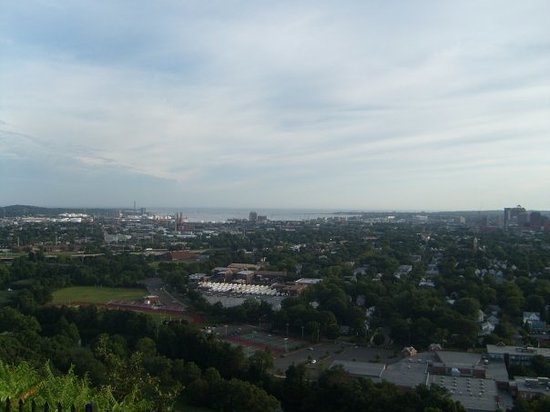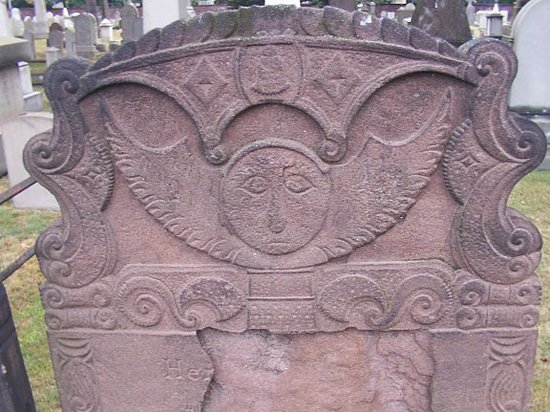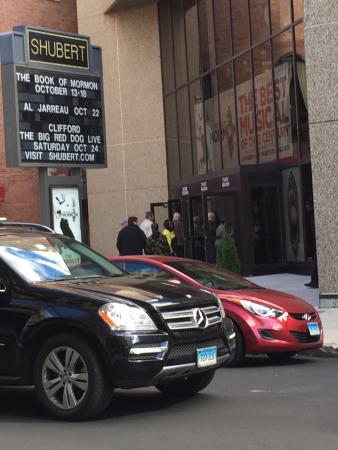What to do and see in New Haven, United States: The Best Places and Tips
The home to Yale University since 1701, the city of New Haven is packed with an unrivaled collection of arts and antiquities, with collections ranging from natural history specimens to antique musical instruments. The towering translucent marble cube of the Beinecke Library contains 600,000 rare volumes, including one of the only surviving Gutenberg Bibles. The Yale University Art Gallery is as famous for its collection as it is for its building, a Modernist masterpiece designed by Louis Kahn.
Restaurants in New Haven
1. Yale University Art Gallery
Overall Ratings
5 based on 786 reviews
Yale University Art Gallery is the oldest college art museum in America. The Gallery’s encyclopedic holdings of 200,000 objects range from ancient times to the present day and represent civilizations from around the globe. FREE and open to the public. On December 12, 2012, the Yale University Art Gallery celebrated the grand opening of the renovated and expanded museum. The expanded Gallery transforms the visitor experience of both the museum and its esteemed collections. The project united the 1953 modernist structure designed by Louis Kahn, the 1928 Old Yale Art Gallery, and the 1866 Street Hall into one continuous structure while maintaining the distinctive architectural identity of each.
Reviewed By kzsull01 - Windsor, Connecticut
My husband and I visited the Yale University Art Gallery in New Haven, Connecticut on Sunday, March 4th, 2018. This museum is excellent and offers a comprehensive view of various types of art. It has quite an impressive and beautifully curated collection of objects. We have visited this museum multiple times in the past and have always found it to be very enjoyable, interesting and educational. Each different type of art on display is in its own gallery, usually having multiple rooms, and has a very nice overview describing the art as well as such aspects as its historical, cultural, political and religious impact, depending on what is applicable. We spent about an hour in the museum this time and did not see all the exhibits. Our focus this time was on the special exhibits on the fourth floor as well as a few of the galleries on the second floor that we did not have the opportunity to spend as much time in as we would have liked during our last visit. It would probably take at least four hours to see the entire museum. This museum is definitely worth the visit and has a very nice added bonus of free admission. The only drawback of this museum is that it does not offer free parking and you may have to pay to park depending upon where you park and when you come.
The ‘Japan’s Global Baroque, 1550 – 1650’ special exhibit was exquisite with elegant objects illustrating the critical role that both imported and domestic goods played in Japanese art and culture during the momentous period of the 16th and 17th centuries. The ‘Pompeii: Photographs and Fragments’ special exhibit highlights the changing representations over time of Pompeii, a city destroyed by the eruption of Mount Vesuvius in A.D. 79 and since then frozen in time through excavation and preservation. Large-scale photographs of Pompeii are on display and show the ongoing cycles of deterioration and preservation that mark it as a living landscape. Images of reliefs, frescoes, paintings and sculptures as well as fragments of ancient Roman wall paintings and a number of other different types of domestic objects from the period and region are also displayed within this exhibit making it both very interesting and unique. Both these special exhibits were nicely done and worth seeing.
In addition to the special exhibits, we went to the second floor. On the second floor was beautiful European Art, including vibrant Italian Renaissance paintings, a gallery of Dutch Art as well as excellent paintings by such artists as Claude Monet, Vincent van Gogh, Pierre-Auguste Renoir, Edgar Degas and many others. Also on this floor was a large collection of Asian Art, including exhibits on the ‘Line as Design in Japanese Art’, the ‘Origin of Chinese Writings’, art from the Safavid (modern day Iranian) dynasty, art of a popular, playful, and powerful Hindu god Krishna, with the ‘Krishna: The Divine Cowherd’ exhibit, and much, much more.
Below I included what we saw during our visit in late November 2017 to give highlights on the remaining galleries in the museum to provide a complete review of the entire museum and all it has to offer, which is definitely quite a bit.
On the first floor we enjoyed the African Art exhibit highlighting major themes that unite different local traditions to understand the aesthetics, meaning, and historical depth associated with this art. On display were many items, including masks, sculptures, statuettes, chairs, jewelry, ceramics, textiles and horns. This was a nicely done exhibit. Also on the first floor was Ancient American Art, with art of the Maya, from Mexico to the Andes. There was also Art of the Ancient Mediterranean with objects providing insights into politics, culture and religion, including statues, coins, wood carvings, vases, ceramic figurines, numismatic curiosities as well as many other artifacts. The next gallery on the first floor was the Dura-Europos (modern day Syria) gallery. Included was Tomb24 in the Necropolis at Dura-Europos. Also in the exhibit was armor, the shrine to the god Mithras, jewelry, pottery and textiles. In addition, there was the first known painting of the Virgin Mary and the earliest surviving house church. All the exhibits on the first floor were very interesting, enjoyable and educational, with much historical significance.
On floor 2E there was American Art before 1900, with historical paintings on the American Revolution, including George Washington at Princeton and Trenton and other paintings by John Trumbull depicting such subjects as the Declaration of Independence and the Battle of Bunker Hill. As we continued through the American Art galleries there were portrait miniatures, self-portrait prints, sculptures by Augustus Saint-Gaudens and landscape paintings of multiple places, such as, the Catskills, Niagara Falls and Mount Katahdin, all very beautiful.
There was also quite an extensive collection of American Decorative Art housed in multiple galleries, broken down into time periods, from the 17th century to the present day. In these galleries were many items, such as, furniture, including chairs, chests and highboys. There was also silver, tin glaze earthenware, pottery, dinnerware, and rooms from both a North Branford and a Hebron home, among many other items. In addition, there was an impressive exhibit on American coins, medal and silver from 1670 to the present as well as Benjamin Franklin items on display.
The third floor had an Indo-Pacific Art Gallery, with the art of maritime South East Asia, as well as a Modern and Contemporary Art and Design exhibit with paintings, including some by Pablo Picasso, sculptures, furniture and decorative arts.
We highly recommend this museum. It definitely has a lot to offer, much more than what I have mentioned here. I only provided some highlights in this write-up based on our experience during our visit. We hope that you have the opportunity to visit it and enjoy it as much as we did.
2. Beinecke Rare Book & Manuscript Library
Overall Ratings
5 based on 200 reviews
Reviewed By acukiert - sao paulo, Brazil
This is a fantastic place to visit, although it could be seen in less then an hour. The architecture is fantastic, qnd the books....no words. If you are part of a research protocol, you would have access to some really old books. Simply amazing.
3. Yale Center for British Art
Overall Ratings
4.5 based on 290 reviews
Note: The Center is temporarily closed for building conservation through February 2016. We apologize for any inconvenience. The Yale Center for British Art is a public art museum and world-renowned research institute. Presented to Yale University by Paul Mellon (Yale College Class of 1929), the Center houses the largest collection of British art outside the United Kingdom. The collection of paintings, sculpture, prints, drawings, rare books, and manuscripts reflects the development of British art and life from the Elizabethan period to the present day. Works on view include masterpieces by Thomas Gainsborough, J.M.W. Turner, and John Constable, as well as artists from Europe and America who lived and worked in Britain. Perhaps its greatest treasure is the building itself, a masterpiece of modern architecture designed by architect Louis I. Kahn. Located in downtown New Haven, the Center is near many of the city's best restaurants, theaters, and shops.
Reviewed By sundown_10 - Maryland
My husband and I thoroughly enjoyed the vast collection of British art. The museum presents the works in an artistic way where the art is accessible to view.
4. Yale University
Overall Ratings
4.5 based on 657 reviews
One of the country's oldest and most prestigious universities.
Reviewed By Norfaryanti K
I love the architecture of the buildings on this campus. The campus has various facilities catered to the visitors, from the Visitor Center, cafes, restaurants, clothing shops, and others. I recommended the tourist to go for their Visitor tour at the Visitor Center, and you are entitled to 15% discount at the Yale Bookshop.
5. Yale Peabody Museum of Natural History
Overall Ratings
4.5 based on 485 reviews
This museum has a diverse collection ranging from Indian artifacts to Egyptian art to a large bird collection.
Reviewed By didr - Connecticut
This museum has inspired many a future archeologist/anthropologist/artist; the displays are well organized and there is lots of fascinating reading material to educate those of us new to much of natural history. Worth visiting over and over again; there is something new to discover with each trip.
6. East Rock Park
Overall Ratings
4.5 based on 135 reviews
Reviewed By JJFlash7 - New Haven, Connecticut
Great neighborhood park- playground and river views and East Rock ....great for dog walking and meeting other neighbors, soccer games most weekends....walk along the river or canoeing...very scenic views of the river, East Rock mountain ...and people watching
7. Knights of Columbus Museum
Overall Ratings
4.5 based on 102 reviews
A journey through history, art & faith.
Reviewed By nanascurse - Meriden, Connecticut
My husband and I loved our first visit to the Knights of Columbus Museum. We were anxious to see the WWI Exhibit. We are quite impressed! Through displays and artifacts, the reasons for the war were made clear and America's late entry into the war...MoreThank you for visiting, and for sharing your experience. Our Christmas show opens in mid November. Please come again!
8. Long Wharf Theatre
Overall Ratings
4.5 based on 104 reviews
A theatre that features Broadway shows.
Reviewed By Celeste M - New Haven, Connecticut
Been attending plays here on both Stages since 1968. So many have moved onto to Broadway.
If you enjoy professional live theater this is for you. All genres are presented and the costuming and props are always impeccable and authentic. There are no bad seats and very few disappointments.
A wonderful part of life in this area of Connecticut.
9. Grove Street Cemetery
Overall Ratings
4.5 based on 68 reviews
Reviewed By ChipCache - Pittsburgh, Pennsylvania
Some graves -- of those of small children or those that have been washed away by age -- are very stirring and emotional for me. Others are incredibly massive memorials, statues really, and they obviously convey a story of wealth and good fortune for those interred there. A fascinating look at the history of one of the United States' formative cities through the departed.
10. Shubert Theater
Overall Ratings
4.5 based on 108 reviews
This theater features Broadway shows.
Reviewed By James F
The Shubert Theater has been faithfully restored to its grandeur from the 1940's when it was the Birthplace of American Hits. Musicals like My Fair Lady, the Sound of Music, South Pacific, Oklahoma and Carousel all premiered in New Haven on the Shubert stage. Now it is operated by CAPA, a very competent nonprofit arts organization, and presents a mix of road shows of Broadway musicals, local arts productions like the New Haven Ballet's wonderful Nutcracker each year, the Yale Opera, Russian ballet companies, and musical acts (Roseanne Cash is coming in the Spring of 2018). I have seen Lucinda Williams there twice and my family went to the touring company of the Sound of Music this fall -- all wonderful shows.
I was involved in the efforts to bring the Shubert back in the 1980's when I was working for the City of New Haven. A theater consultant we worked with described it as a "jewel box" of a theater that is beloved by the stars who have performed there.
If you get a chance to see a performance there, you should not pass it up!










